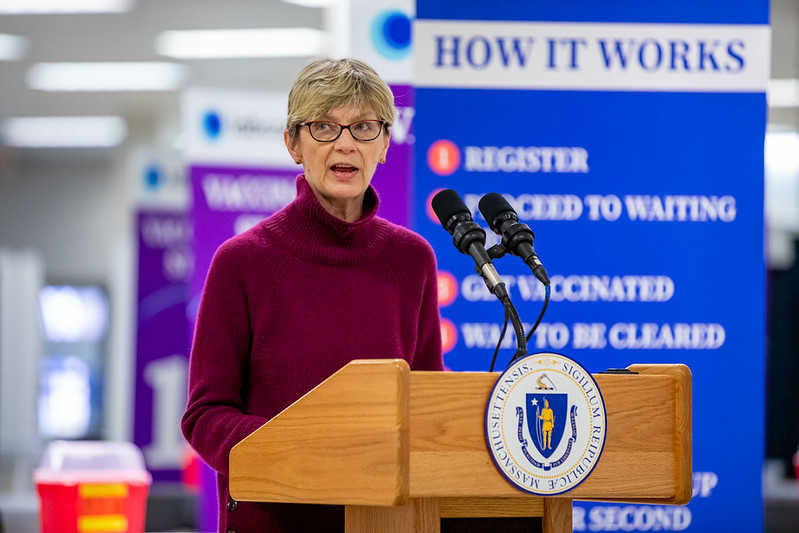The following is a press release by the Massachusetts Department of Public Health, in full transparency.
***

BOSTON – Opioid-related overdose deaths in Massachusetts increased by 5 percent in 2020 compared to 2019, with rates among Black non-Hispanic males making up the largest increase, according to preliminary data released this month by the Massachusetts Department of Public Health (DPH).
There were 2,104 confirmed and estimated opioid-related overdose deaths in 2020, an estimated 102 more than the prior year and slightly above the previous peak of 2,102 in 2016.
This is the first increase in annual opioid-related deaths in Massachusetts in three years and coincides with the extraordinary public health challenges stemming from the COVID-19 pandemic.
Among Black non-Hispanic males, the confirmed opioid-related overdose death rate increased the most – by 69 percent – from 32.6 to 55.1 per 100,000 people, the highest increase of any ethnic or racial group in 2020.
There were 28 communities that experienced a notable decrease in opioid-related incidents responded to by Emergency Medical Services (EMS) from 2019 to 2020, including Chelsea, Framingham, and Worcester.
[broadstreet zone=”53130″]
Nationwide, Massachusetts is among the states with the smallest increases in all drug overdose deaths. Preliminary data released last month from the Centers for Disease Control and Prevention (CDC) show drug overdose deaths surged by 29 percent nationally in the year between September 2019 and September 2020, with Massachusetts showing a smaller increase in the single digits.
Overall, the 2020 opioid-related overdose death rate of 30.2 per 100,000 people is approximately 1 percent lower than in 2016 (30.6 per 100,000).
The Baker-Polito Administration continues to invest in efforts to combat the opioid epidemic, especially among the Commonwealth’s most disproportionately impacted communities, building on its work to double spending to address this crisis since 2015. Recent investments have focused on new intervention efforts among youth and expanded supports for people in recovery, and the Administration’s FY 2022 budget proposal includes a total of $375.3 million across state agencies to address substance misuse, a 7 percent increase over last year.
“Both the COVID-19 pandemic and the opioid epidemic have underscored the importance of supporting disproportionately impacted communities, and as we address both issues, our Administration has continued to focus on equity as a core component of our response,” said Governor Charlie Baker. “While Massachusetts experienced a smaller increase in drug-related deaths compared to the rest of the country, these trends make clear we have to redouble our efforts. That’s why we have continued to ensure access to life-saving tools like naloxone, focus on prevention strategies especially in communities of color, and provide pathways to treatment and supports for those struggling with addiction. We remain focused on fighting the opioid epidemic even as we continue to battle COVID, and are committed to funding new and innovative programs to support our residents.”
[broadstreet zone=”58610″]
“We recognize that the anxiety, stress, and loss of social supports resulting from the COVID-19 pandemic over the past year have been especially challenging for people who struggle with substance use disorder,” said Lt. Governor Karyn Polito. “We have made hard-won gains in our fight against the opioid crisis and we will continue to support our residents dealing with substance use disorder.”
Since the start of the pandemic, the Administration has continued to expand existing overdose-targeted initiatives and implement innovations to ensure uninterrupted substance use treatment and support. DPH has distributed more than 110,000 naloxone kits to opioid treatment programs, community health centers, hospital emergency departments, and houses of correction since March 2020.
Designated units to treat COVID-positive individuals were created to counteract the fear of exposure and allow facilities to safely transfer or refer patients to treatment service settings. With a blanket exception from the Substance Abuse and Mental Health Services Administration (SAMHSA), 49 percent of Massachusetts opioid treatment program patients have been receiving take-home doses of medication for opioid use disorder (MOUD) as of December 2020, compared to the pre-pandemic average of 16 percent in December 2019.
[broadstreet zone=”59946″]
The Baker-Polito Administration continues to invest millions of dollars in federal grants toward new substance use treatment, support, intervention, and education programs, primarily for residents experiencing the highest burden of this epidemic, including those in communities of color and individuals with a history of homelessness or incarceration. Most recently, this includes a combined $9.4 million for high school substance use and mental health response teams, youth substance use prevention programs, and support services for young adults in recovery. Additionally, $2.3 million in federal grants will fund a reentry pilot to provide recovery-based wraparound services for incarcerated Black and Latino men with a history of substance abuse who are at risk of fatal overdoses upon release.
“The unprecedented challenges created by the COVID-19 pandemic did not slow down our aggressive fight against the opioid epidemic,” said Health and Human Services Secretary Marylou Sudders. “We will continue to target critical resources and develop innovative solutions to reduce opioid addiction and overdose deaths.”
“The disparities in overdose trends among Black men underscore the need to continue our public health-centered, data-driven approach to the opioid epidemic that is disproportionately impacting high-risk, high-need priority populations,” said Public Health Commissioner Monica Bharel, MD, MPH. “Too many families have lost loved ones to overdoses and we remain steadfast in our commitment to providing recovery supports needed, especially for those hardest-hit by the opioid crisis.”

DPH has prioritized a data-driven, equity-based public health model by focusing on populations most burdened by disease and illness. Preliminary data show that Black non-Hispanic residents had the highest confirmed opioid-related overdose death rate increase – 57 percent – from 22.1 to 34.8 per 100,000 people in 2020. They were followed by Asian Pacific Islander non-Hispanic residents (27 percent, from 2.6 to 3.3 per 100,000) and Hispanic residents (9 percent, from 32.4 to 35.4 per 100,000). Hispanic men continue to have the highest rates of opioid-related deaths at 57.9 per 100,000.
The powerful synthetic opioid fentanyl continues to be the main driver of opioid-related overdose deaths in Massachusetts. The rate of fentanyl present among opioid-related overdose deaths where a toxicology report was available was 92 percent in 2020, preliminary data show.
The rate of heroin or likely heroin present in opioid-related overdose deaths was 14 percent, continuing a downward trend since 2014.
After fentanyl, cocaine continues to be the next most prevalent drug among opioid-related overdose deaths, present in toxicology reports at a rate of 46 percent in 2020.
[broadstreet zone=”70107″]
The presence of benzodiazepines, amphetamines, and prescription opioids in opioid-related overdose deaths have remained stable, toxicology screens show.
At the municipal level, several communities experienced a notable decrease in opioid-related overdose deaths from 2019 to 2020, including Lawrence, Lowell, Lynn, and New Bedford.
Middlesex County marked its fourth consecutive year of declining opioid-related overdose deaths from its peak of 402 in 2016 to 299 last year, a 26 percent decrease.
Among the other findings of the latest opioid report:
- Between 2019 and 2020, the confirmed opioid-related overdose death rate for all residents increased slightly: 28.7 per 100,000 in 2019 and 30.2 per 100,000 in 2020.
- In the same time period, the confirmed opioid-related overdose death rate per 100,000 for Black non-Hispanic, Asian Pacific Islander non-Hispanic, and Hispanic men increased, while it decreased for white non-Hispanic men.
- Between 2019 and 2020, the confirmed opioid-related overdose death rate increased for Black non-Hispanic, Hispanic, and white non-Hispanic women.
- Males comprise 73 percent of all opioid-related overdose deaths occurring in 2020.
- 55 percent of opioid-related deaths occurred in people who were between 25 and 44 years old
- 36 percent were between 45 and 65 years old
- In 2020, males aged 25-34 continued to represent the greatest number, 22 percent, of suspected opioid-related incidents treated by EMS with a known age and sex.
- Naloxone was administered in 96 percent of acute opioid overdoses occurring in 2020. Of all opioid-related EMS incidents in 2020, 55.3 percent were categorized as acute opioid overdoses.
- Approximately 209,000 individuals in Massachusetts received prescriptions for Schedule II opioids in the first quarter of 2021, a 46 percent decrease from 390,532 in the first quarter of 2015.


